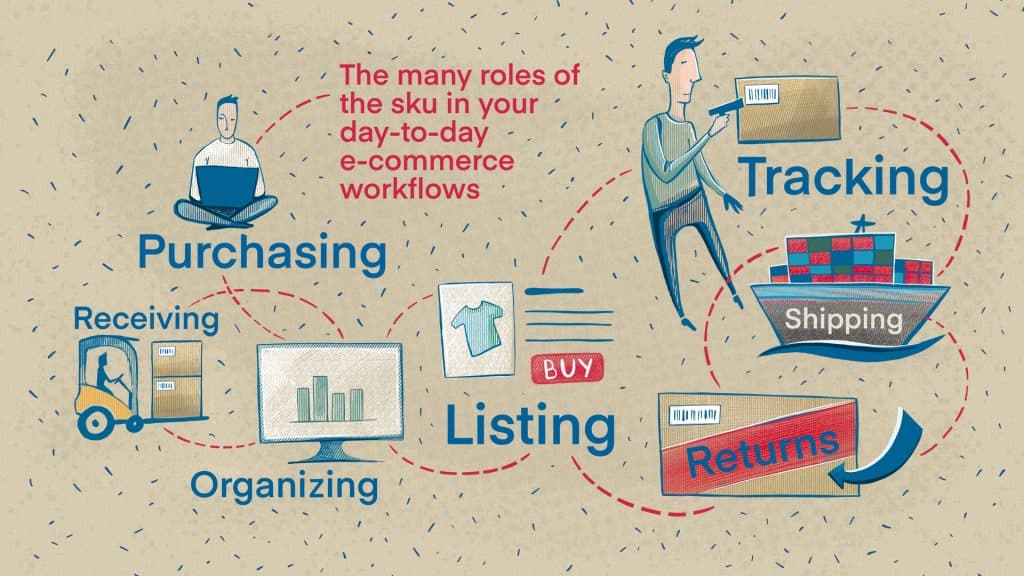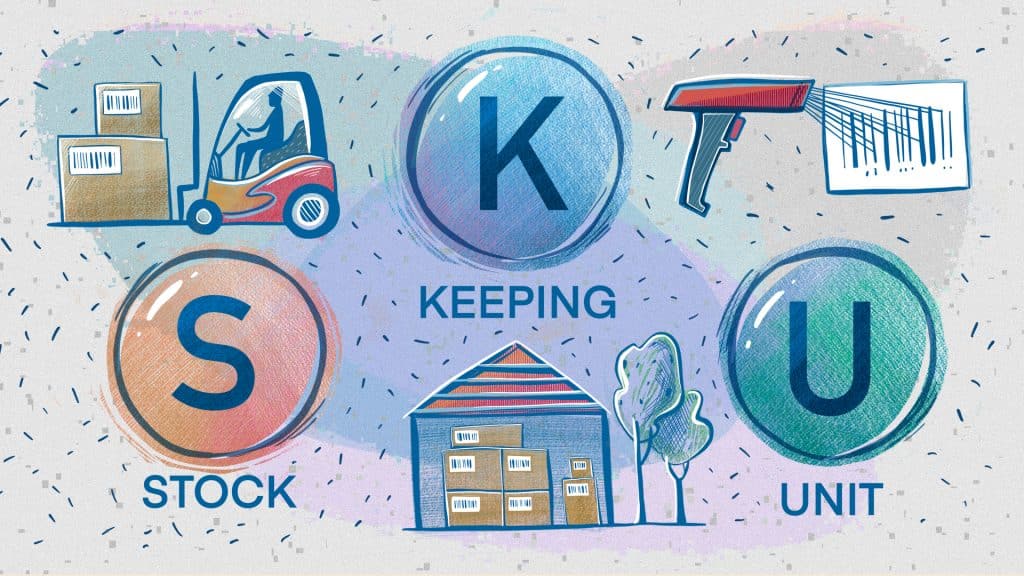
The Stock Keeping Unit (SKU) is one of the most powerful series of letters and numbers in retail. When it comes to your ecommerce business, the SKU is critical for inventory management, maintaining your omnichannel catalog, fulfilling orders, and tracking the movement of your merchandise.
Additionally, SKUs are key to unlocking the organizational, tracking, and reporting features of a unified software platform like Descartes Sellercloud and a WMS (Warehouse Management System) like Skustack. The ability to properly create and maintain accurate SKU data means that you can run an optimized, data-driven omnichannel ecommerce brand that is not only profitable but scalable as well.
At every stage of your business, the SKU plays multiple vital roles. Tracing the end-to-end flow of a product SKU through your business proves just how important SKUs are.
Purchasing
Before a unit of merchandise enters your stock, it likely starts in someone else’s—either as a component or a finished product. When it comes time to purchase from your external suppliers, referencing a vendor’s SKU ensures you order the exact items you need.
Descartes Sellercloud makes creating purchase orders simple. Our purchasing features allow you to create, receive, pay, submit, and manage your purchase orders across all of your vendors from a single, convenient platform.
Taken further, when inventory levels get low, Descartes Sellercloud’s predictive purchasing tools can automatically reorder what you need with enough lead time so that you are never out of stock. This eliminates the overselling and backorders that can disappoint customers and negatively impact your brand.
Once orders are complete, tracking based on vendor’s SKUs allows you to generate accurate Cost of Goods Sold (COGS) calculations for your Profit & Loss summaries and your tax filings. This data can also be used to identify meaningful price and quantity fluctuations in your orders over time, so that you can be sure that you are working with the best possible suppliers and are being efficient in your spending.
Receiving
Once your orders arrive, SKUs can accurately compare purchase orders, invoices, packing lists, and physical goods to ensure you received the stock you paid for in the desired quantities and varieties. Should things not line up, the SKU is a key detail in resolving purchase-related disputes.
A SKU is also the most efficient way to bring new stock into both your WMS and your omnichannel inventory management platform. Skustack, Descartes Sellercloud’s patented WMS, makes it easy for your warehouse team to scan incoming SKUs and instantly add them to your inventory, update the on-hand quantities of your omnichannel listings, and indicate to your warehouse team where the stock should be stored.
Organizing
When you take possession of stock and inventory, you have the opportunity to assign your own unique SKU to the products. Most SKUs are created with combinations of eight to 12 letters and numbers. This can be done randomly, but most brands opt to create SKUs that include relevant details such as:
Product Names
Using a SKU that is an exact match for your product name can cause some confusion; however, using a relevant abbreviation or derivation of your product name in its SKU can help improve its practicality. Everything from invoicing to inventory management to fulfilling orders can become more efficient and error-free when there is an obvious connection between an SKU and the product it references.
Product Characteristics
For products that have varieties of colors, sizes, and/or styles, it can be helpful to assign a common string of characters to begin an SKU and then vary or add a few characters based on these differentiating characteristics. For instance, if you sell various shirts, you may create SKUs where the first characters represent the design, the next represents the style, the next represents the color, and the last represents the size.
As such, 24VNCK-OR-LG could be the SKU for a large orange V-neck version of shirt pattern 24. 24CREW-GN-SM could be the SKU for a small, green, crew-neck version of that same pattern.
Version Differences
As you iterate on your products over time, SKUs can help keep these iterations sorted, especially if you continue to carry and sell the older versions. Adding a character to your SKU that denotes a version number can be particularly helpful should you need to quickly identify a particular version of an item you sell.
This is how Apple develops SKUs for its various iPhone iterations. Specifically, they assign specific characters that indicate the product model and country. Once SKUs have been assigned, they can be used to manage the physical organization of your warehouse and business-wide inventory stockpiles.
Not only does Descartes Sellercloud allow you to locate where your inventory is stored (down to the bin level), but it also allows you to organize your inventory across multiple warehouses and logistics partners. Once a product has its unique SKU, you know exactly where it is.

Listing
Your SKUs are important organizational tools for tying the correct products to the relevant listings across all channels you sell. While most third-party marketplaces will assign their own identification codes to your products, like Amazon’s ‘Amazon Standard Identification Number’ (ASIN), having your own purposefully created Merchant SKU is commonly regarded as a best practice.
One of the benefits of relying on an omnichannel management platform like Descartes Sellercloud is that these multiple identifiers from your listings across multiple marketplaces can all be related to the same product SKU. Once again, the humble SKU makes inventory management and data tracking simpler.
There are also specific instances where your own SKUs may reference other SKUs in your inventory. One situation where this happens is in the creation of kits and bundles. Rather than just selling related items piecemeal, it is possible to create combinations of multiple products from your inventory to sell using unique, alternate SKUs.
By bundling groups of products in this fashion, Descartes Sellercloud allows you to use these kit-specific SKUs to create listings across the different channels where you sell and manage the related inventory seamlessly. The same product can be picked and shipped based on its own SKU or as a part of a bundled SKU.
For instance, a package of four batteries with the SKU BATAAX4 could also be sold as a bundle of two units and assigned the SKU BATAAX8. The customer is being sold eight batteries instead of four, but the order is picked and fulfilled as two units of the battery four-pack. This strategy can be particularly beneficial to upsell products and help move higher inventory volumes.
Taken further, Descartes Sellercloud’s Shadow SKU feature allows sellers to create different SKUs for the same product for many different use cases. One of the most common is allowing sellers to list the same items multiple times on a marketplace. This makes it possible to test and assess catalog listing variations across multiple categories on your marketplace channels.
It also allows you to track the performance of particular marketing campaigns without replacing your existing catalog listings. So, while the Shadow and parent SKUs pull from the same inventory stockpiles, you can use the unique SKUs to distinguish the sales data and the effectiveness of any differentiating marketing decisions.
Tracking
Every time a product moves, you need to have a record of where it came from and where it ends up. Failure to do so can result in inventory-count inaccuracies, order-picking problems, and even more costly mistakes like overselling or bungled orders.
SKUs are one of the main ways ecommerce brands can track the movement of their stock and inventory throughout their business. Skustack makes it possible to easily track your inter- and intra-warehouse product movements. Whether bin-to-bin, warehouse-to-warehouse, or even SKU-to-SKU, Skustack allows your warehouse team to scan and relocate products while instantly updating your inventory records.
SKUs can also be used to track other aspects of your inventory, like lot numbers, expiration dates, and serial numbers. By relating these more granular data points to particular SKUs, you can add increased layers of complexity and deeper insights into your overall inventory management.
Shipping
The SKU is vital for accurate and efficient shipments. More than any other distinguishing factor, the SKU is the reliable way your warehouse team and fulfillment partners know exactly what to pick and pack to fulfill a customer’s order.
With Skustack, picklists can be generated on a product-based, order-based, or kit-based level so your warehouse workers know precisely which SKUs to retrieve and which shelves and bins to go to. The lists can even be divided so that multiple team members can work together to pick an order.
The Skublox put-to-light, pack-to-light system allows picked orders to be accurately sorted and packed according to a color-coded light wall. Scanning an item illuminates where each picked item should be placed. On the other side of the wall, slots turn green, letting your packing team know when all the items of an order have been accounted for and are ready to be packed and shipped.
Once orders are packed, Shipbridge, Descartes Sellercloud’s multi-carrier shipping platform, can use the data associated with your orders and order items to generate accurate shipping labels, billing information, and package details for your shipping partners.
All of this is made possible by SKU-based product identification.
Returns
Nobody likes to deal with returns, but with accurate SKU-based record-keeping, you can reduce many potential headaches associated with processing RMAs. SKUs can be used to verify that customers have returned the correct items. They also make it simple for your warehouse team to process returned items into your inventory.
These are some impactful ways the simple SKU intertwines nearly every aspect of your ecommerce business. Moreover, you must have the software platform and tools necessary to leverage SKU-based data to its fullest potential.
Contact us directly for a free demo and see how you can maximize the potential of your SKUs by running a more efficient brand, selling more products, and scaling to reach new customers.




